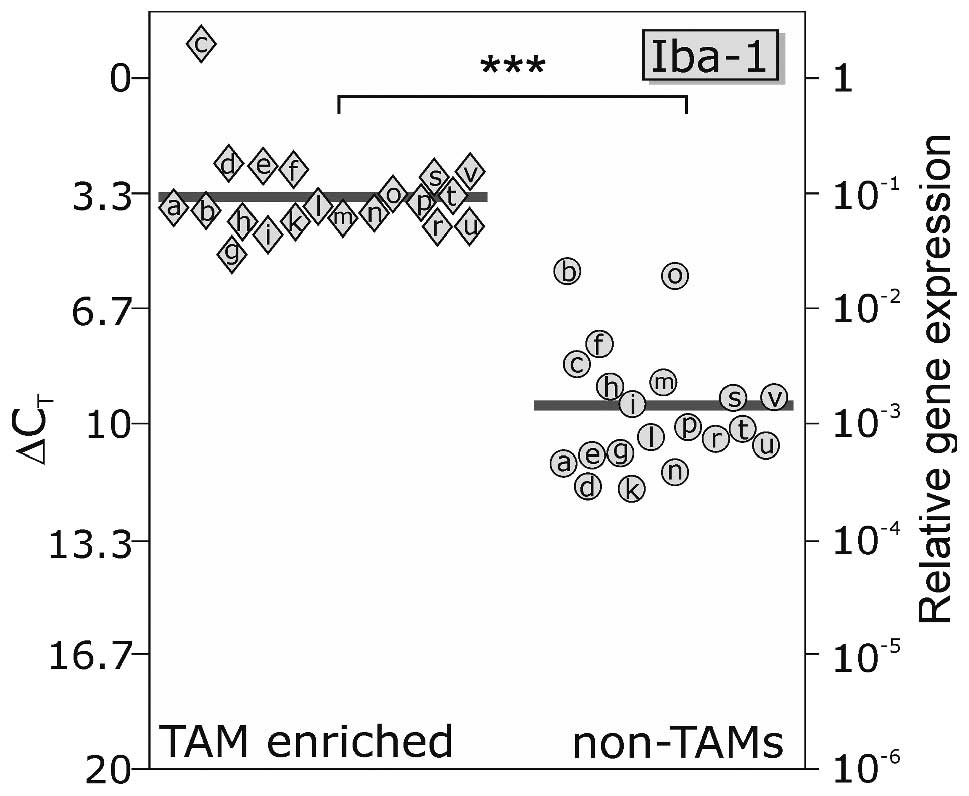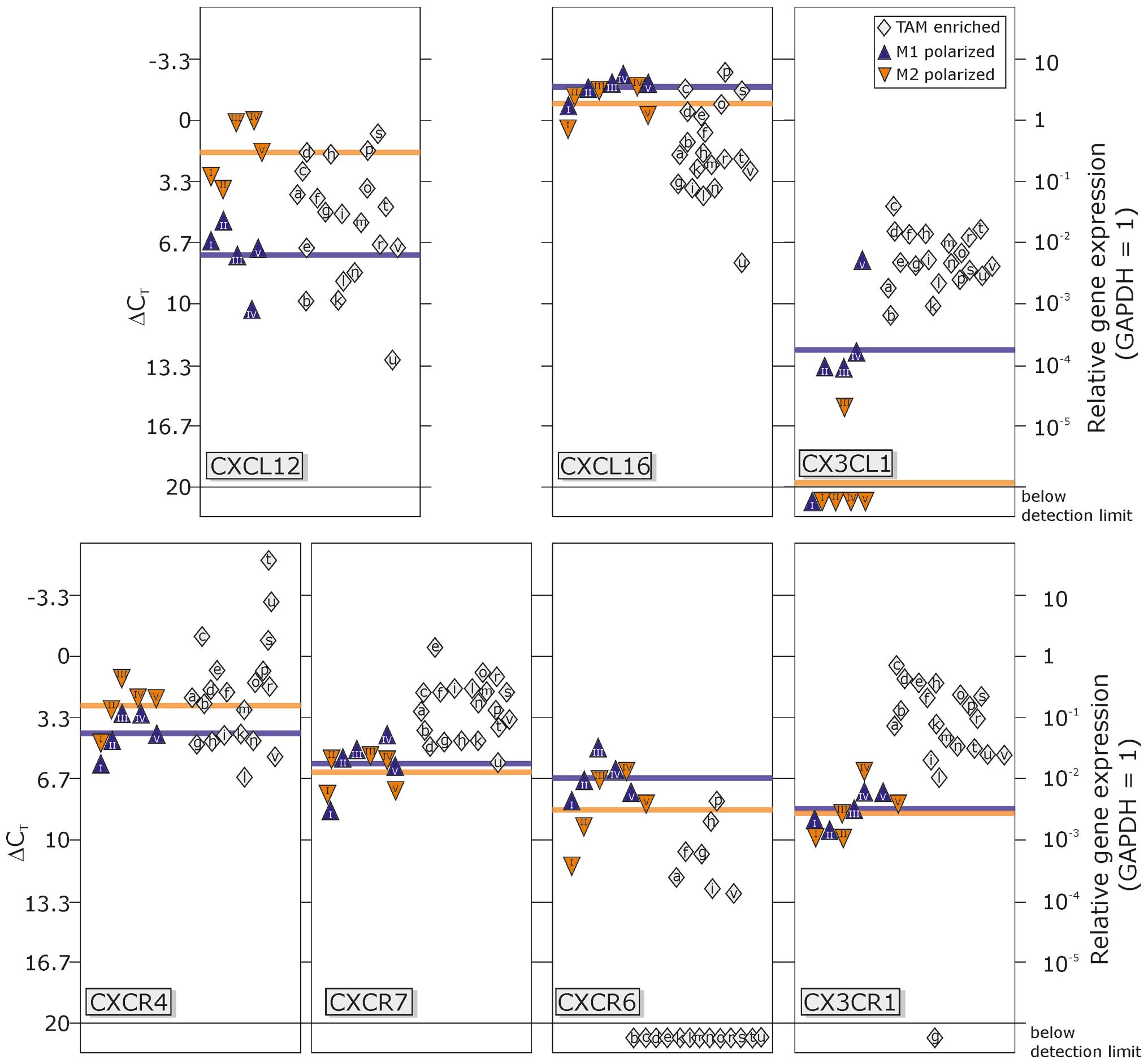|
1
|
Elinav E, Nowarski R, Thaiss CA, Hu B, Jin
C and Flavell RA: Inflammation-induced cancer: crosstalk between
tumours, immune cells and microorganisms. Nat Rev Cancer.
13:759–771. 2013. View
Article : Google Scholar : PubMed/NCBI
|
|
2
|
Ohgaki H and Kleihues P: Epidemiology and
ethiology of gliomas. Acta Neuropathol. 109:93–108. 2005.
View Article : Google Scholar : PubMed/NCBI
|
|
3
|
Badie B and Schartner JM: Flow cytometric
characterization of tumor-associated macrophages in experimental
gliomas. Neurosurgery. 46:957–961. 2000.PubMed/NCBI
|
|
4
|
Li W and Graber MB: The molecular profile
of microglia under the influence of glioma. Neuro Oncol.
14:958–978. 2012. View Article : Google Scholar : PubMed/NCBI
|
|
5
|
Markovic DS, Glass R, Synowitz M, Rooijen
Nv and Kettenmann H: Microglia stimulate the invasiveness of glioma
cells by increasing the activity of metalloprotease-2. J
Neuropathol Exp Neurol. 64:754–762. 2005. View Article : Google Scholar : PubMed/NCBI
|
|
6
|
Zhai H, Heppner FL and Tsirka SE:
Microglia/macrophages promote glioma progression. Glia. 59:472–485.
2011. View Article : Google Scholar : PubMed/NCBI
|
|
7
|
Mantovani A, Germano G, Marchesi F,
Locatelli M and Biswas SK: Cancer-promoting tumor-associated
macrophages: new vistas and open questions. Eur J Immunol.
41:2522–2525. 2011. View Article : Google Scholar : PubMed/NCBI
|
|
8
|
Kielian T, van Rooijen N and Hickey WF:
MCP-1 expression in CNS-1 astrocytoma cells: implications for
macrophage infiltration into tumors in vivo. J Neurooncol. 56:1–12.
2002. View Article : Google Scholar : PubMed/NCBI
|
|
9
|
Galasso JM, Stegman LD, Blaivas M,
Harrison JK, Ross BD and Silverstein FS: Experimental gliosarcoma
induces chemokine receptor expression in rat brain. Exp Neurol.
161:85–95. 2000. View Article : Google Scholar : PubMed/NCBI
|
|
10
|
Okada M, Saio M, Kito Y, Ohe N, Yano H,
Yoshimura S, Iwama T and Takami T: Tumor-associated
macrophage/microglia infiltration in human gliomas is correlated
with MCP-3, but not MCP-1. Int J Oncol. 34:1621–1627.
2009.PubMed/NCBI
|
|
11
|
Held-Feindt J, Hattermann K, Müerköster
SS, Wedderkopp H, Knerlich-Lukoschus F, Ungefroren H, Mehdorn HM
and Mentlein R: CX3CR1 promotes recruitment of human
glioma-infiltrating microglia/macrophages (GIMs). Exp Cell Res.
316:1553–1566. 2010. View Article : Google Scholar : PubMed/NCBI
|
|
12
|
Hattermann K and Mentlein R: An infernal
trio: the chemokine CXCL12 and its receptors CXCR4 and CXCR7 in
tumor biology. Ann Anat. 195:103–110. 2013. View Article : Google Scholar : PubMed/NCBI
|
|
13
|
Hattermann K, Held-Feindt J, Ludwig A and
Mentlein R: The CXCL16-CXCR6 axis in glial tumors. J Neuroimmunol.
260:47–54. 2013. View Article : Google Scholar : PubMed/NCBI
|
|
14
|
Hattermann K1, Held-Feindt J, Lucius R,
Müerköster SS, Penfold ME, Schall TJ and Mentlein R: The chemokine
receptor CXCR7 is highly expressed in human glioma cells and
mediates antiapoptotic effects. Cancer Res. 70:3299–3308. 2010.
View Article : Google Scholar : PubMed/NCBI
|
|
15
|
Hattermann K, Ludwig A, Gieselmann V,
Held-Feindt J and Mentlein R: The chemokine CXCL16 induces
migration and invasion of glial precursor cells via its receptor
CXCR6. Mol Cell Neurosci. 39:133–141. 2008. View Article : Google Scholar : PubMed/NCBI
|
|
16
|
Domanska UM, Kruizinga RC, den Dunnen WF,
Timmer-Bosscha H, de Vries EG and Walenkamp AM: The chemokine
network, a newly discovered target in high grade gliomas. Crit Rev
Oncol Hematol. 79:154–163. 2011. View Article : Google Scholar : PubMed/NCBI
|
|
17
|
Sciumè G, Santoni A and Bernardini G:
Chemokines and glioma: invasion and more. J Neuroimmunol. 224:8–12.
2010.PubMed/NCBI
|
|
18
|
Grage-Griebenow E, Zwatzky R, Kahlert H,
Brade L, Flad H and Ernst E: Identification of a novel dendritic
cell-like subset of CD64+/CD16+ blood
monocytes. Eur J Immunol. 31:48–56. 2001. View Article : Google Scholar : PubMed/NCBI
|
|
19
|
Krausgruber T, Blazek K, Smallie T,
Alzabin S, Lockstone H, Sahgal N, Hussell T, Feldmann M and Udalova
IA: IRF5 promotes inflammatory macrophages polarization and
TH1–TH17 responses. Nat Immunol. 12:231–238.
2011. View
Article : Google Scholar : PubMed/NCBI
|
|
20
|
Verreck FA1, de Boer T, Langenberg DM, van
der Zanden L and Ottenhoff TH: Phenotypic and functional profiling
of human proinflammatory type-1 and anti-inflammatory type-2
macrophages in response to microbial antigens and IFN-γ- and
CD40L-mediated costimulation. J Leukoc Biol. 79:285–292.
2006.PubMed/NCBI
|
|
21
|
Schäfer H, Struck B, Feldmann EM, Bergmann
F, Grage-Griebenow E, Geismann C, Ehlers S, Altevogt P and Sebens
S: TGF-β1-dependent L1CAM expression has an essential role in
macrophage-induced apoptosis resistance and cell migration of human
intestinal epithelial cells. Oncogene. 32:180–189. 2013.
|
|
22
|
Kennedy BC, Showers CR, Anderson DE,
Anderson L, Canoll P, Bruce JN and Anderson RCE: Tumor-associated
macrophages in glioma: friend or foe? J Oncol. 2013:4869122013.
View Article : Google Scholar : PubMed/NCBI
|
|
23
|
Ruffel B, Affara NI and Coussens LM:
Differential macrophage programming in the tumor microenvironment.
Trends Immunol. 33:119–126. 2012. View Article : Google Scholar : PubMed/NCBI
|
|
24
|
Miller RJ, Rostene W, Apartis E, Banisadr
G, Biber K, Milligan ED, White FA and Zhang J: Chemokine action in
the nervous system. J Neurosci. 28:11792–11795. 2008. View Article : Google Scholar : PubMed/NCBI
|
|
25
|
Vandercappellen J, Van Damme J and Struyf
S: The role of CXC chemokines and their receptors in cancer. Cancer
Lett. 267:226–244. 2008. View Article : Google Scholar : PubMed/NCBI
|
|
26
|
Kakinuma T and Hwang ST: Chemokines,
chemokine receptors, and cancer metastasis. J Leukoc Biol.
79:639–651. 2006. View Article : Google Scholar : PubMed/NCBI
|
|
27
|
Zlotnik A: Chemokines and cancer. Int J
Cancer. 119:2026–2029. 2006. View Article : Google Scholar : PubMed/NCBI
|
|
28
|
Lu H, Ouyang W and Huang C: Inflammation,
a key event in cancer development. Mol Cancer Res. 4:221–233. 2006.
View Article : Google Scholar : PubMed/NCBI
|
|
29
|
Ben-Baruch A: The multifaceted roles of
chemokines in malignancy. Cancer Metastasis Rev. 25:357–371. 2006.
View Article : Google Scholar : PubMed/NCBI
|
|
30
|
Platten M, Kretz A, Naumann U, Aulwurm S,
Egashira K, Isenmann S and Weller M: Monocyte chemoattractant
protein-1 increases microglial infiltration and aggressiveness of
gliomas. Ann Neurol. 54:388–392. 2003. View Article : Google Scholar : PubMed/NCBI
|
|
31
|
Allavena P, Sica A, Solinas G, Porta C and
Mantovani A: The inflammatory micro-environment in tumor
progression: the role of tumor-associated macrophages. Crit Rev
Oncol Hematol. 66:1–9. 2008. View Article : Google Scholar : PubMed/NCBI
|
|
32
|
Sica A, Schioppa T, Mantovani A and
Allavena P: Tumour-associated macrophages are a distinct M2
polarised population promoting tumour progression: potential
targets of anti-cancer therapy. Eur J Cancer. 42:717–727. 2006.
View Article : Google Scholar
|
|
33
|
Helm O, Held-Feindt J, Grage-Griebenow E,
Reiling N, Ungefroren H, Vogel I, Krüger U, Becker T, Ebsen M,
Röcken C, Kabelitz D, Schäfer H and Sebens S: Tumor-associated
macrophages exhibit pro- and anti-inflammatory properties by which
they impact on pancreatic tumorigenesis. Int J Cancer. Jan
23–2014.(Epub ahead of print). View Article : Google Scholar
|
|
34
|
Arenberg DA, Keane MP, DiGiovine B, Kunkel
SL, Strom SR, Burdick MD, Iannettoni MD and Strieter RM: Macrophage
infiltration in human non-small-cell lung cancer: the role of CC
chemokines. Cancer Immunol Immunother. 49:63–70. 2000. View Article : Google Scholar : PubMed/NCBI
|
|
35
|
Balkwill F: Cancer and the chemokine
network. Nat Rev Cancer. 4:540–550. 2004. View Article : Google Scholar
|
|
36
|
Mantovani A, Allavena P, Sozzani S, Vecchi
A, Locati M and Sica A: Chemokines in the recruitment and shaping
of the leukocyte infiltrate of tumors. Semin Cancer Biol.
14:155–160. 2004. View Article : Google Scholar : PubMed/NCBI
|
|
37
|
Ueno T, Toi M, Saji H, Muta M, Bando H,
Kuroi K, Koike M, Inadera H and Matsushima K: Significance of
macrophage chemoattractant protein-1 in macrophage recruitment,
angiogenesis, and survival in human breast cancer. Clin Cancer Res.
6:3282–3289. 2000.PubMed/NCBI
|
|
38
|
Monti P, Leone BE, Marchesi F, Balzano G,
Zerbi A, Scaltrini F, Pasquali C, Calori G, Pessi F, Sperti C, Di
Carlo V, Allavena P and Piemonti L: The CC chemokine MCP-1/CCL2 in
pancreatic cancer progression: regulation of expression and
potential mechanisms of antimalignant activity. Cancer Res.
63:7451–7461. 2003.PubMed/NCBI
|
|
39
|
Bachleder RE, Wendt MA and Mercurio AM:
Vascular endothelial growth factor promotes breast carcinoma
invasion in an autocrine manner by regulating the chemokine
receptor CXCR4. Cancer Res. 62:7203–7206. 2002.PubMed/NCBI
|
|
40
|
Schioppa T, Uranchimeg B, Saccani A,
Biswas SK, Doni A, Rapisarda A, Bernasconi S, Saccani S, Nebuloni
M, Vago L, Mantovani A, Melillo G and Sica A: Regulation of the
chemokine receptor CXCR4 by hypoxia. J Exp Med. 198:1391–1402.
2003. View Article : Google Scholar : PubMed/NCBI
|
|
41
|
Schutyser E, Struyf S, Proost P,
Opdenakker G, Laureys G, Verhasselt B, Peperstraete L, Van de Putte
I, Saccani A, Allavena P, Mantovani A and Van Damme J:
Identification of biologically active chemokine isoforms from
ascetic fluid and elevated levels of CCL18/pulmonary and
activation-regulated chemokine in ovarian carcinoma. J Biol Chem.
277:24584–24593. 2002. View Article : Google Scholar
|
|
42
|
Sica A, Larghi P, Mancino A, Rubino L,
Porta C, Totaro MG, Rimoldi M, Biswas SK, Allavena P and Mantovani
A: Macrophage polarization in tumor progression. Semin Cancer Biol.
18:349–355. 2008. View Article : Google Scholar
|
|
43
|
Biswas SK, Gangi L, Paul S, Schioppa T,
Saccani A, Sironi M, Bottazzi B, Doni A, Vincenzo B, Pasqualini F,
Vago L, Nebuloni M, Mantovani A and Sica A: A distinct and unique
transcriptional program expressed by tumor-associated macrophages
(defective NF-κB and enhanced IRF-3/STAT1 activation). Blood.
107:2112–2122. 2006.PubMed/NCBI
|
|
44
|
Pyonteck SM, Akkari L, Schuhmacher AJ,
Bowman RL, Sevenich L, Quail DF, Olson OC, Quick ML, Huse JT,
Teijeiro V, Setty M, Leslie CS, Oei Y, Pedraza A, Zhang J, Brennan
CW, Sutton JC, Holland EC, Daniel D and Joyce JA: CSF-1R inhibition
alters macrophage polarization and blocks glioma progression. Nat
Med. 19:1264–1272. 2013. View Article : Google Scholar : PubMed/NCBI
|
|
45
|
Pong WW, Walker J, Wylie T, Magrini V, Luo
J, Emnett RJ, Choi J, Cooper ML, Griffith M, Griffith OL, Rubin JB,
Fuller GN, Piwnica-Worms D, Feng X, Hambardzumyan D, DiPersio JF,
Mardis ER and Gutmann DH: F11R is a novel monocyte prognostic
biomarker for malignant glioma. PLoS One. e775712013. View Article : Google Scholar : PubMed/NCBI
|
|
46
|
Ye XZ, Xu SL, Xin YH, Yu SC, Ping YF, Chen
L, Xiao HL, Wang B, Yi L, Wang QL, Jiang XF, Yang L, Zhang P, Qian
C, Cui YH, Zhang X and Bian XW: Tumor-associated
microglia/macrophages enhance the invasion of glioma stem-like
cells via TGF-β1 signaling pathway. J Immunol. 189:444–453.
2012.PubMed/NCBI
|

















